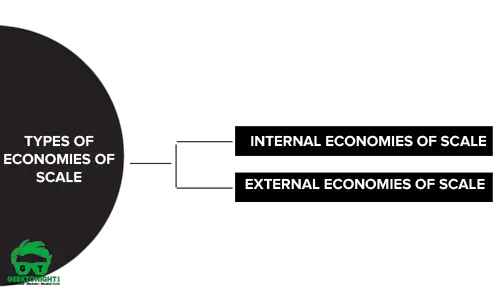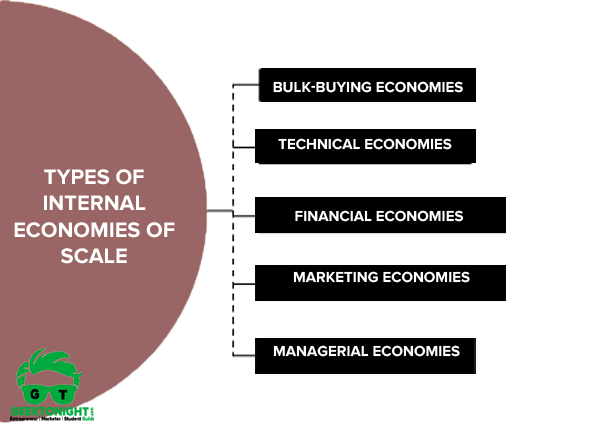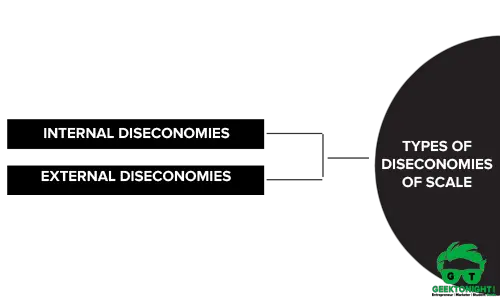What are Economies of scale?
Economies of scale, As a firm expands its production capacity, the efficiency of production also increases. It is able to draw more output per unit of input, leading to low average total costs. This condition is termed as economies of scale.
Economies of scale result in cost-saving for a firm as the same level of inputs yields a higher level of output. A higher level of output results in lower average costs as the total costs are shared over the increased output.
Table of Content [Show]
Types of Economies of Scale
There are two types of economies of scale:

Internal Economies of Scale
Definition: Internal Economies of Scale refers to the economies that a firm achieves due to the growth of the firm itself. When an organisation reduces costs and increases the production, internal economies of scale are achieved.
Internal economies of scale refer to the lower per-unit cost that a firm obtains by increasing its capacity.
Internal economies of scale example, large companies have the aptitude to buy in size, thus lowering the cost per unit of the resources they need to create their products. They can also use the savings to augment profits, or pass the investments to consumers and fight on price.
Types of Internal Economies of Scale
There are five types of internal economies of scale:
- Bulk-buying economies
- Technical economies
- Financial economies
- Marketing economies
- Managerial economies

Let us discuss the different types of internal economies of scale in detail:
- Bulk-buying economies: As a firm grows in size, it requires larger quantities of production inputs, such as raw materials. With increase in the order size, the firm attains bargaining power over the suppliers. It is able to purchase inputs at a discount, which results in lower average cost of production.
- Technical economies: As a firm increases its scale of production, it may use advanced machinery or better techniques for production purposes.
For example, the firm may use mass-production techniques, which provide a more efficient form of production. Similarly, a bigger firm may invest in research and development to increase the efficiency of production. - Financial economies: Often small businesses are perceived as being riskier than larger businesses that develop a credible track record. Therefore, while the smaller firms find it hard to obtain finance at reasonable interest rates, larger firms easily find potential lenders to raise money at lower interest rates. This capital is further used to expand the production scale resulting in low average total costs.
- Marketing economies: The marketing function of a firm incurs a certain cost, such as costs involved in advertising and promotion, hiring sales agents, etc. Many of these costs are fixed and as the firm expands its capacity, it is able to spread the marketing costs over a wider range of products. This results in low-average total costs.
- Managerial economies: As a firm grows, managerial activities become more specialised. For example, a larger firm can further divide its management into smaller departments that specialise in specific areas of business.
Specialist managers are likely to be more efficient as they possess a high level of expertise, experience and qualifications. This reduces the managerial costs in proportion to the scale of production in the firm. Therefore, economies of scale can be achieved with efficient management.
External economies of scale
External economies of scale refer to the economies in production that a firm achieves due to the growth of the overall industry in which the firm operates.
External economies of scale transpire outside a firm, within an industry. Therefore, when an industry’s scope of operations expands, external economies of scale are said to have been achieved.
For example, the creation of a better transportation network, which results in a subsequent fall in the transportation cost of a firm operating within that industry, leads to external economies of scale.
Factors of external economies of scale
- Improvement in transport and communication network
- Focus on training and education within the industry
- Support of other industries
What is Diseconomies of Scale?
Definition: Diseconomies of scale refer to the disadvantages that arise due to the expansion of a firm’s capacity leading to a rise in the average cost of production. Similar to the economies of scale, diseconomies of scale can also be categorised into internal and external diseconomies of scale.
Also Read: Types of Cost
Types of Diseconomies of Scale
There are two types of economies of scale:

Internal diseconomies
Internal diseconomies refer to the diseconomies that a firm incurs due to the growth of the firm itself. These diseconomies of scale result in a decrease in the firm’s output and increase in the long-run average cost.
Type of Internal diseconomies
The two main reasons for internal diseconomies of scale are as follows:
- Managerial inefficiency: When a firm expands its production capacity, control and planning also need to be increased. This requires the administration to be more efficient. Often due to the challenge of managing a bigger firm, managerial responsibilities are delegated to the lower level personnel. As these personnel may lack the required experience to undertake the challenge, it may result in low output at a higher cost.
- Labour inefficiency: When a firm expands its production capacity, work areas may become more crowded leaving little space for each worker to work efficiently.
Moreover, over-specialisation and division of labour in a bigger firm create over-dependence on workers. In such situations, labour absenteeism, lethargy, discontinuation of services, etc., become common, which increase the long-run average cost of production.
External diseconomies
External diseconomies of scale refer to the disadvantages that arise due to an increase in the number of firms in an industry-leading to overproduction.
Factors of external diseconomies of scale
- The concentration of firms within an industry increases the demand for raw materials. This leads to an increase in the prices of raw materials consequently increasing the cost of production in the industry.
- The concentration of firms within an industry increases the demand for skilled labour. This leads to an increase in the wages of the skilled workers consequently increasing the cost of production in the industry.
- The concentration of firms within an industry may lead to problems of waste disposal. Firms are bound to employ expensive waste disposal or recycling methods, which increases the long-run cost of production.
- The concentration of firms within an industry may lead to excessive need for advertising and promotion, consequently increasing the cost of production in the industry.
Leave a Reply